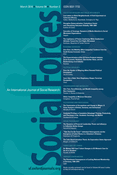-
PDF
- Split View
-
Views
-
Cite
Cite
Jay A. Irwin, Amigas y Amantes: Sexually Nonconforming Latinas Negotiate Family By Katie L. Acosta Rutgers University Press. 2013. 192 pages. $24.95 paper, $75.00 cloth, Social Forces, Volume 94, Issue 3, March 2016, Page e76, https://doi.org/10.1093/sf/sou044
Close - Share Icon Share
The book Amigas y Amantes: Sexually Nonconforming Latinas Negotiate Family focuses on the intersectionalities experienced by Latina women who identify as lesbian, bisexual, or queer. The author, Katie Acosta, does a nice job of situating the research she conducted in the New England area within the larger subfields of study including sociology of families, sexualities, gender, and race/ethnicity. The book is drawn from extensive interview and participant-observation data, which is able to elucidate the complexities that exist for women on the fringes of many social groups, such as being nonheterosexual Latina women in a society dominated by heterosexual white male norms. Furthermore, Acosta utilizes a number of strong theoretical and methodological tools to bring these data to life, including standpoint theory and a commitment to collaborative research. It is with these unique data and the author's lens that the reader is brought into the worlds of the diverse participants, in ways that are informative to all scholars and students interested in family, race and ethnicity, and sexuality.
The author's main themes center on the complex lives the women interviewed lead. Specifically, the author weaves an intersectional approach into chapters focused on embodying femininity and doing gender, the role of religion, interracial and interethnic relationships, parenting, and care work within families. Each chapter highlights resistance and vulnerable borders between communities and identities. For example, in discussions of gender and femininity, interviewees discuss the importance of being seen as female and embodying appropriate femininity, especially in interactions with their mothers. Embodying certain types of approved femininity (particularly not being masculine and becoming a proper woman) allows mothers to gain some level of comfort with their daughters' sexual norm violations.
The author uses the work of Chicano and feminist theorist Gloria Anzaldúa to situate her own findings and arguments. The themes of a “mestiza consciousness,” “borderlands,” and “nepantla” are used in various chapters to describe the porous boundaries that sexually nonconforming Latinas present in their own stories about their lives. Acosta's keen attention to the conflicting social norms that these women face (from within their ethnic communities, within the LGBTQ community, with regard to their religious communities, and various family formations) highlights nicely the displacement of vulnerable identities and positions. Specifically, in the chapter focusing on the importance of religion, Acosta highlights the difficulties these women, many of whom were raised Catholic, experience and the lack of acceptance within their faiths. Many of the women discuss that they remain spiritual and believers, despite not feeling comfortable within churches in which they were raised or in churches they have visited since moving to the United States.
Acosta also utilizes the work of sociologist Arlie Hochschild to discuss the emotional labor that falls on many of the women included in her data. Specifically, this book seeks to “queer” emotional work by examining this type of labor in a nonheterosexual frame. Due to the marginalized positions these women occupy both within society and within their families, the reader gains an understanding of the ways that emotional work is shaped in alternative families. Acosta's data and writing suggest that the women in this study engage in a large amount of caring for both biological families and families of choice. Family scholars interested in fictive kinship, chosen families, and queer family forms would likely find this work very interesting and relevant to their own work.
Acosta discusses at length methodological decisions and concerns related to this kind of research in a way that is beneficial for qualitative researchers engaging in research among communities in which they are members. Recruitment in studies of marginalized communities is always challenging, and Acosta details the strategies she utilized in detail. She also discusses the importance of language in the context of this work, and due to the key personal feature of being bilingual, she includes both original Spanish and English translation within the text for readers when applicable. She details her commitment to the nuances that the original Spanish can convey to the reader that a translation might approximate but cannot replicate fully. The author's discussion of language, access, trust, and her own identity would no doubt be useful for other scholars attempting to embark on similar research.
This work, while useful to scholars in the fields discussed above, would also be very useful for an upper-level undergraduate or graduate course on intersectionality, sexuality, gender, or race/ethnic studies. The work is challenging, yet accessible enough for advanced undergraduate students. As many teacher-scholars know, qualitative readings often assist in making difficult theoretical concepts come alive for students, and this work by Acosta would no doubt bring to life the intricacies that exist in the lives of nonheterosexual Latinas. This text would likely be a great tool for a discussion-based class, as students would find the stories a great starting point for in-depth discussions.


